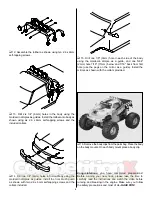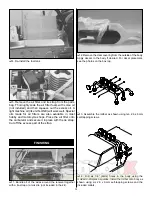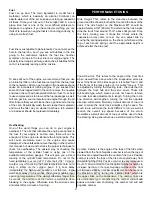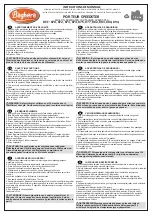
16
The First Tank
Your first tank of fuel should be running the truck at a very
rich high-speed needle valve setting. This allows the fuel to
carry as much oil as possible into the engine to lubricate the
internal parts during the break-in.
1.
Open the needle valve 2-3/4 turns from fully closed
(counterclockwise). This is factory set already, but
check it to make sure. When closing the high-speed
needle, close the needle until you feel some resistance.
DO NOT
overtighten or you will damage the engine.
2.
Start the engine.
3.
Once the engine is started, open the high-speed needle
valve around 1/8 turn at a time, finding the setting where
the engine just barely runs. This may take a few times
adjusting the needle, running the truck away from you and
back, then adjusting the needle. The truck will perform
sluggishly and stall from time to time - that is normal.
4.
Run the truck back and forth at medium speeds, slowly
accelerating and decelerating the truck.
5.
After a minute or two of running, make sure the engine
is not overheating by putting a drop of water on the
cylinder head and watching it boil away. If it boils away
immediately, stop the engine and allow it to cool. Open
the high-speed needle around a 1/4 turn before starting
again. This is a good habit to get into every time you run
to ensure that the engine does not overheat during any
run. Looking at the smoke that comes out the exhaust
is also an indicator of how rich or lean the engine is
running. If there is a good amount of smoke coming out
of the exhaust, then chances are good that you are
running rich.
6.
Run the truck back and forth at a medium speed until
the tank is almost out of fuel. Do not allow the tank to
run out of fuel. This leans out the engine and can cause
overheating (See How To Stop Your Engine).
7.
Stop the engine and allow the engine to cool before the
second tank. This normally takes around 10 minutes.
Tanks 2-5
Turn in the needle valve (clockwise) around 1/12 turn from
the previous setting. Run the truck back and forth. You
should notice that the truck will perform better during each
run. Stop the truck periodically to check for overheating. If it
is too hot, stop the engine. Wait for it to cool, then open up
the needle valve and restart. After the 5th tank, you should
be near to the peak performance of the engine.
10 Ways To Ensure A Long Life From Your Engine:
1.
Keep your engine clean. Dirt will act as insulation on an
engine. It will not be able to shed heat as easily. Use a
good air filter to keep dirt out of your engine and clean
it often.
2.
Do not over-lean your engine.
3.
Do not run your engine with little or no load. Don’t
throttle up the engine to full throttle when the wheels are
not in contact with the ground.
4.
Do not overheat the engine. This goes along with
keeping it clean and not over-leaning the engine.
5.
Do not use a fuel with a low oil content. Make sure you
use a fuel from a reputable manufacturer, such as
DuraTrax Red Alert.
6.
Avoid using old fuels in the engine. Always run all of the
fuel out of the engine. After running for the day, use an
after-run oil and work it into the engine by turning the
flywheel or pulling the engine recoil slowly.
7.
Do not use a fuel with a nitromethane (often called nitro)
content over 20%.
8.
Do not scratch the piston or cylinder sleeve. Avoid
jamming something into the exhaust port when removing
or re-installing the clutch or flywheel. Use a special tool
called a crankshaft locking tool, which is installed in the
glow plug hole.
9.
Do not use silicone sealer on the engine joints. Silicone
sealer contains acetic acid, which is corrosive if it gets
inside your engine.
10. Do not allow any water inside the engine. This sounds
easy, but temperature changes can cause condensation
inside the engine. This is a good reason to use an
after-run oil. Store your engine inside the house, not in
a garage or shed where there will be temperature
extremes.
If you are having problems with your engine consult the
engine troubleshooting flow chart on page 16. The
following are some potential problems.
Glow Plug
The glow plug is an item that will wear out and need
replacement from time to time. It is a good idea to remove
the glow plug before your first run, heat it and see how well
it glows. You should see a bright orange glow from the
filament. If a coil or two will not glow or the plug will not glow
at all, replace the plug. If the engine quits when you remove
the glow starter, the plug might need to be changed,
although this may be because you are running too rich and
need to screw in your high-speed needle some. Look at the
glow plug when you are running the engine. If you see some
bubbles coming from around the plug, replace the glow plug
(copper) gasket, or both the plug and gasket. The only real
way to test a glow plug is to replace it. Make sure you have
a spare plug or two on hand every time that you run the
Maximum MT.
ENGINE MAINTENANCE





































